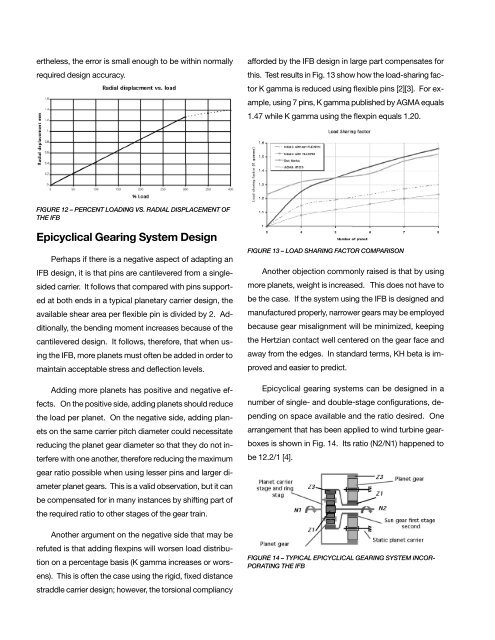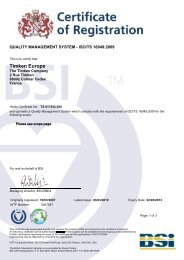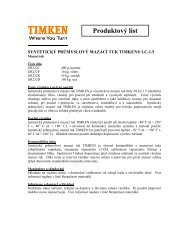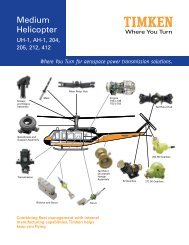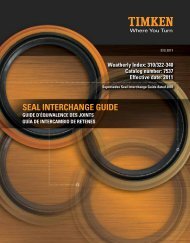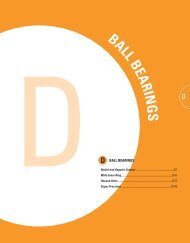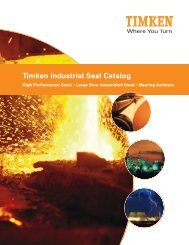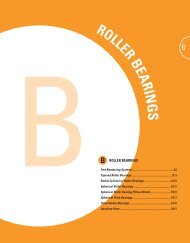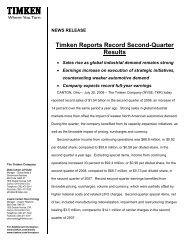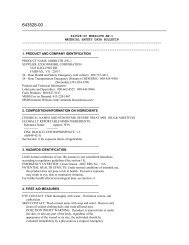Technical Paper - Timken
Technical Paper - Timken
Technical Paper - Timken
You also want an ePaper? Increase the reach of your titles
YUMPU automatically turns print PDFs into web optimized ePapers that Google loves.
ertheless, the error is small enough to be within normally<br />
required design accuracy.<br />
FIGURE 12 – PERCENT LOADING VS. RADIAL DISPLACEMENT OF<br />
THE IFB<br />
Epicyclical Gearing System Design<br />
Perhaps if there is a negative aspect of adapting an<br />
IFB design, it is that pins are cantilevered from a single-<br />
sided carrier. It follows that compared with pins support-<br />
ed at both ends in a typical planetary carrier design, the<br />
available shear area per flexible pin is divided by 2. Ad-<br />
ditionally, the bending moment increases because of the<br />
cantilevered design. It follows, therefore, that when us-<br />
ing the IFB, more planets must often be added in order to<br />
maintain acceptable stress and deflection levels.<br />
Adding more planets has positive and negative ef-<br />
fects. On the positive side, adding planets should reduce<br />
the load per planet. On the negative side, adding plan-<br />
ets on the same carrier pitch diameter could necessitate<br />
reducing the planet gear diameter so that they do not in-<br />
terfere with one another, therefore reducing the maximum<br />
gear ratio possible when using lesser pins and larger di-<br />
ameter planet gears. This is a valid observation, but it can<br />
be compensated for in many instances by shifting part of<br />
the required ratio to other stages of the gear train.<br />
Another argument on the negative side that may be<br />
refuted is that adding flexpins will worsen load distribu-<br />
tion on a percentage basis (K gamma increases or wors-<br />
ens). This is often the case using the rigid, fixed distance<br />
straddle carrier design; however, the torsional compliancy<br />
afforded by the IFB design in large part compensates for<br />
this. Test results in Fig. 13 show how the load-sharing fac-<br />
tor K gamma is reduced using flexible pins [2][3]. For ex-<br />
ample, using 7 pins, K gamma published by AGMA equals<br />
1.47 while K gamma using the flexpin equals 1.20.<br />
FIGURE 13 – LOAD SHARING FACTOR COMPARISON<br />
Another objection commonly raised is that by using<br />
more planets, weight is increased. This does not have to<br />
be the case. If the system using the IFB is designed and<br />
manufactured properly, narrower gears may be employed<br />
because gear misalignment will be minimized, keeping<br />
the Hertzian contact well centered on the gear face and<br />
away from the edges. In standard terms, KH beta is im-<br />
proved and easier to predict.<br />
Epicyclical gearing systems can be designed in a<br />
number of single- and double-stage configurations, de-<br />
pending on space available and the ratio desired. One<br />
arrangement that has been applied to wind turbine gear-<br />
boxes is shown in Fig. 14. Its ratio (N2/N1) happened to<br />
be 12.2/1 [4].<br />
FIGURE 14 – TYPICAL EPICYCLICAL GEARING SYSTEM INCOR-<br />
PORATING THE IFB


